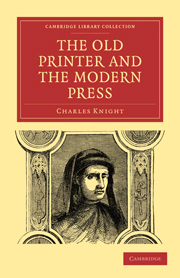Summary
The following account of the invention of printing is given by an ancient German chronicler of the name of Trithemius, who appears to have personally known one of the three persons who clearly seem to have the best title to be called the inventors of printing.
“At this time, in the city of Mentz on the Rhine in Germany, and not in Italy, as some have erroneously written, that wonderful and then unheard-of art of printing and characterizing books was invented and devised by John Guttenberger, a citizen of Mentz, who, having expended almost the whole of his property in the invention of this art, and on account of the difficulties which he experienced on all sides, was about to abandon it altogether; when, by the advice, and through the means, of John Fust [or Faust], likewise a citizen of Mentz, he succeeded in bringing it to perfection. At first they formed [engraved] the characters or letters in written order on blocks of wood, and in this manner they printed the vocabulary called a ‘Catholicon.’ But with these forms [blocks] they could print nothing else, because the characters could not be transposed in these tablets, but were engraved thereon, as we have said. To this invention succeeded a more subtle one, for they found out the means of cutting the forms of all the letters of the alphabet, which they called matrices, from which again they cast characters of copper or tin of sufficient hardness to resist the necessary pressure, which they had before engraved by hand.
- Type
- Chapter
- Information
- The Old Printer and the Modern Press , pp. 167 - 176Publisher: Cambridge University PressPrint publication year: 2010First published in: 1854



